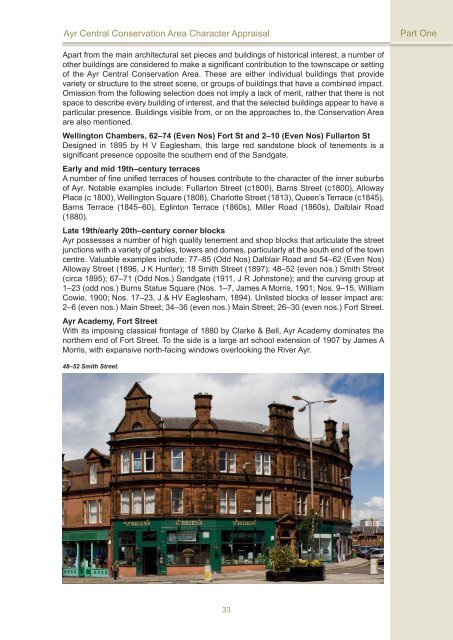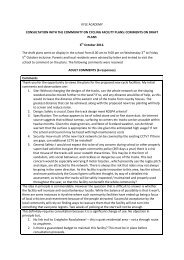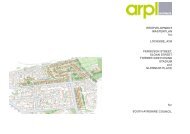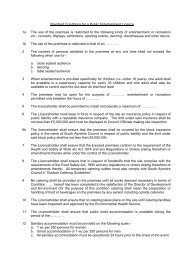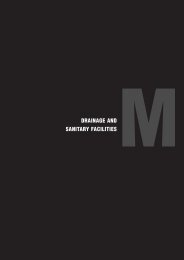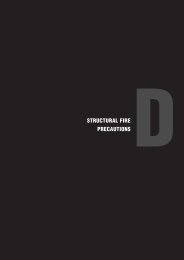Ayr Central Conservation Area Character Appraisal - South Ayrshire ...
Ayr Central Conservation Area Character Appraisal - South Ayrshire ...
Ayr Central Conservation Area Character Appraisal - South Ayrshire ...
You also want an ePaper? Increase the reach of your titles
YUMPU automatically turns print PDFs into web optimized ePapers that Google loves.
<strong>Ayr</strong> <strong>Central</strong> <strong>Conservation</strong> <strong>Area</strong> <strong>Character</strong> <strong>Appraisal</strong><br />
Part One<br />
Apart from the main architectural set pieces and buildings of historical interest, a number of<br />
other buildings are considered to make a significant contribution to the townscape or setting<br />
of the <strong>Ayr</strong> <strong>Central</strong> <strong>Conservation</strong> <strong>Area</strong>. These are either individual buildings that provide<br />
variety or structure to the street scene, or groups of buildings that have a combined impact.<br />
Omission from the following selection does not imply a lack of merit, rather that there is not<br />
space to describe every building of interest, and that the selected buildings appear to have a<br />
particular presence. Buildings visible from, or on the approaches to, the <strong>Conservation</strong> <strong>Area</strong><br />
are also mentioned.<br />
Wellington Chambers, 62–74 (Even Nos) Fort St and 2–10 (Even Nos) Fullarton St<br />
Designed in 1895 by H V Eaglesham, this large red sandstone block of tenements is a<br />
significant presence opposite the southern end of the Sandgate.<br />
Early and mid 19th–century terraces<br />
A number of fine unified terraces of houses contribute to the character of the inner suburbs<br />
of <strong>Ayr</strong>. Notable examples include: Fullarton Street (c1800), Barns Street (c1800), Alloway<br />
Place (c 1800), Wellington Square (1808), Charlotte Street (1813), Queen’s Terrace (c1845),<br />
Barns Terrace (1845–60), Eglinton Terrace (1860s), Miller Road (1860s), Dalblair Road<br />
(1880).<br />
Late 19th/early 20th–century corner blocks<br />
<strong>Ayr</strong> possesses a number of high quality tenement and shop blocks that articulate the street<br />
junctions with a variety of gables, towers and domes, particularly at the south end of the town<br />
centre. Valuable examples include: 77–85 (Odd Nos) Dalblair Road and 54–62 (Even Nos)<br />
Alloway Street (1896, J K Hunter); 18 Smith Street (1897); 48–52 (even nos.) Smith Street<br />
(circa 1895); 67–71 (Odd Nos.) Sandgate (1911, J R Johnstone); and the curving group at<br />
1–23 (odd nos.) Burns Statue Square (Nos. 1–7, James A Morris, 1901; Nos. 9–15, William<br />
Cowie, 1900; Nos. 17–23, J & HV Eaglesham, 1894). Unlisted blocks of lesser impact are:<br />
2–6 (even nos.) Main Street; 34–36 (even nos.) Main Street; 26–30 (even nos.) Fort Street.<br />
<strong>Ayr</strong> Academy, Fort Street<br />
With its imposing classical frontage of 1880 by Clarke & Bell, <strong>Ayr</strong> Academy dominates the<br />
northern end of Fort Street. To the side is a large art school extension of 1907 by James A<br />
Morris, with expansive north-facing windows overlooking the River <strong>Ayr</strong>.<br />
48–52 Smith Street.<br />
33


